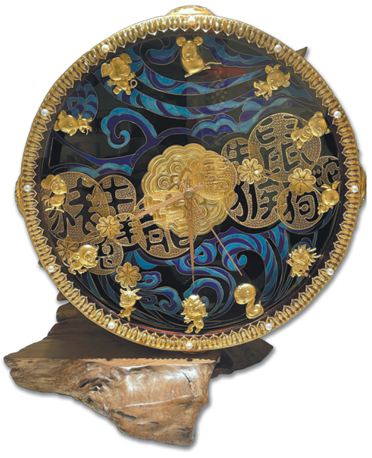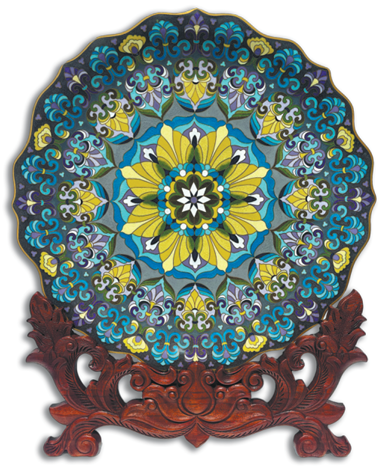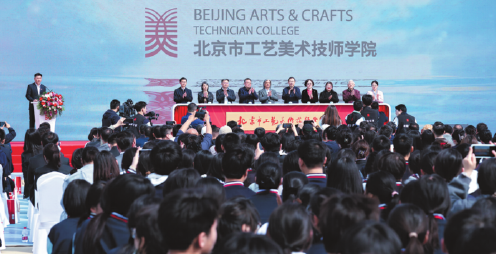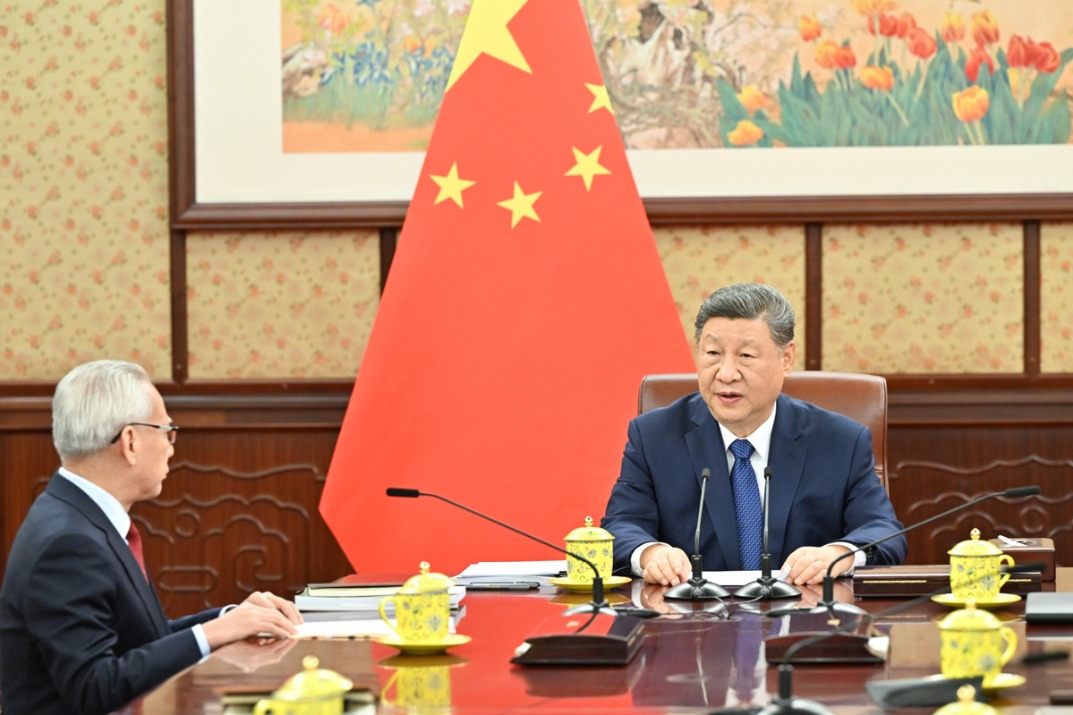Art college's status redefines excellence
Students receive access to more resources as school cultivates future talents, Yang Feiyue reports.

In a well-lit studio, 18-year-old Dong Run shyly introduced a carved lacquer plaque to arts and crafts masters who stepped into an art school in early April.
The plaque features a rooster looking back at its plush tail feathers, with a canopy of cockscomb flowers above its head.
The rooster, known for its bright redhead comb, appears to be wearing a natural "crown", while the vivid red cockscomb flower's crest-like appearance resembles the rooster's head, Dong points out.
"The symbolism is rooted in both visual metaphor and linguistic play. When the flower is paired with the rooster in imagery or metaphor, it suggests adding a crown to something already crowned. This combination serves as a cultural emblem of layered excellence and distinguished status," she explains.
Whenever the veteran artists gave her an approving glance, Dong says her confidence was boosted and it encouraged her to go deeper into the details.
"If you look closer, you can see the rooster's neck feathers consist of hundreds of sifang flowers, a symmetrical floral motif that radiates outward in four directions, which symbolizes boundless growth," she says.
It took a month for her and two classmates to complete the work under the instruction of their mentor Wang Jianming, a carved lacquer expert with more than a decade of experience.
Seeing her work displayed publicly for the first time has helped Dong decide to pursue an art career.
"I've loved art since childhood. When it was time to choose a high school, I knew I wanted one that would let me grow as an artist," she recalls.
In 2022, this predisposition led her to the Beijing Senior Technical School of Arts and Crafts founded in 1980. It has recently been upgraded to the Beijing Arts and Crafts Technician College.
The status upgrade makes it one of the country's few technical colleges dedicated solely to arts and crafts education, according to authorities.
Dong's work is among more than 150 pieces on display at the Crafting Dreams, Shaping Futures exhibition. The exhibition opening coincided with the college's inauguration on April 8.
The exhibition features contemporary cultural and creative designs and folk arts highlighting Yanjing Bajue (the eight outstanding imperial handicrafts of Beijing), including cloisonne, jade carving, filigree inlay and gold lacquer inlay, exemplifying the excellence of Chinese arts and artists.
"They are collaborations between more than 20 resident masters and students. It's a manifest of our pedagogy," says Liu Jinfang, principal of the college.
She notes that the college's status will help to better align its educational mission with Beijing's role as a national cultural center.
"With a strong focus on arts and crafts, our school will steadily expand its influence in society while deepening international exchanges and enhancing collaboration between schools and industries," Liu says.
These efforts are expected to attract more young people to engage in the inheritance and development of traditional craftsmanship, contributing to the cultivation of skilled talent for the country's cultural development, she adds.
Liu deems the school's new status as recognition of its past efforts.
In 2024, five of its faculty members were granted the Beijing Arts and Crafts Master title.
"Under the guidance of these masters, we have implemented a talent training model that integrates learning with hands-on practice — an approach we describe as 'master-led, industry-integrated education'," Liu explains.
Through this model, they have cultivated many highly skilled professionals in the arts and crafts field.
"Students progress through our six-year academic system, developing from novices into advanced technicians and even master-level artisans. Many graduates have gone on to excel in various sectors of the arts and crafts industry, becoming key contributors and leaders in their respective enterprises," she notes.
With the academy's upgraded status, Liu says it will expand partnerships with intangible cultural heritage institutions.
Wang, the lacquer carving instructor with the school, feels the upgrade will bring more opportunities to innovate teaching methods.
"We're particularly focused on deepening integrated, skill-based education that blends traditional craftsmanship with modern, creative thinking, such as interdisciplinary training and fostering students' abilities in technique and innovation," Wang says.
Over the years, the art school has actively refined its professional programs. One such program is paired with a national arts and crafts master, he says.
"This approach not only enhances our technical skills but also allows younger teachers to gain inspiration from students' creativity. It's a process built on collaborative innovation and mutual growth among master artisans, instructors and students," he says.
Duan Tiyu, chairman of Beijing Gongmei Group, one of the major forces behind the country's arts and crafts development, pledged continued collaboration with the college in talent development and industrial innovation, fostering a win-win partnership between education and enterprise.
The upgrade marks a momentous occasion for the group and the broader arts and crafts industry in the capital, Duan says.
"In this new era, a pressing question we face is how to blend traditional arts and crafts with contemporary concepts to develop highly skilled, innovative professionals who can meet the evolving market demand," Duan says.
"The institute's founding provides us with a critical platform and an excellent opportunity to address this challenge," he adds.
Duan hopes the college will further explore and preserve China's outstanding traditional culture and integrate these unique cultural elements into education, so treasured legacies will be passed down and rejuvenated in the modern era.
He also proposes to combine industry and education to encourage teachers to take on different roles and keep pace with the latest techniques, which will enable them to update teaching content and improve instructional quality.
At the launch ceremony, Zhao Xiutao, deputy director of the vocational capacity development division of the Beijing Municipal Human Resources and Social Security Bureau, outlines the college's key priorities in strengthening academic management, expanding infrastructure and enrollment, enhancing faculty development, and increasing advanced technician training.
Wang Xiaobing, also from the Beijing bureau, commends the college's accomplishments in vocational education and urges further progress in industry-academia integration, advancing cultural innovation, and strengthening international exchanges.
Dong expects to gain access to rich learning resources and interact with more senior craftsmen because of her school's higher status.
From her experience, she emphasizes that the school's greatest strength lies in its resource of legendary artisans.
Under the guidance of carved lacquer art masters like Li Zhigang and Wang, students receive hands-on training rarely available elsewhere.
"They inspect every detail of our work and demonstrate corrections in person," Dong says.
"Once, while carving the intricate floral patterns for the rooster's neck, I struggled for days. The petals were tiny and my cuts kept going awry. I almost gave up," she says, recalling one of her setbacks.
But the masters' patience became her lifeline. "They'd sit beside us, showing us how to steady the blade. Slowly, I improved."
With the school's upgraded resources, Dong eagerly looks ahead.
"The school didn't just teach me a skill, it connected me to a lineage of artists. One day, I hope I can contribute to the field," she says.




Today's Top News
- Opening of new gateway can help foster global economic and trade cooperation
- The farmer, the snake and Japan's memory hole
- Crossing a milestone in the journey called Sinology
- China-Russia media forum held in Beijing
- Where mobility will drive China and the West
- HK community strongly supports Lai's conviction






























